Why Does the U.S. Hate Iran? Think Oil and Strategic Power.
Iran is a paragon of human rights, democracy and social liberty compared with some of our Middle Eastern allies. But our policymakers aren’t letting that sway them.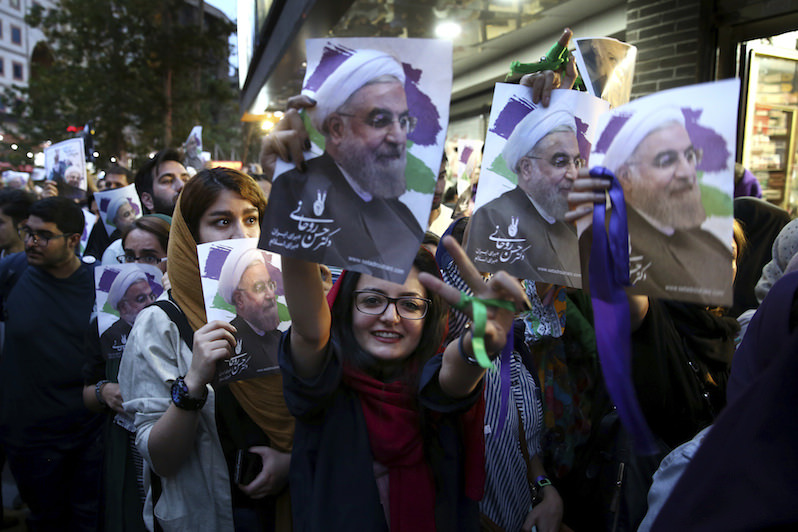 Supporters of progressive Iranian President Hassan Rouhani celebrate his re-election in Tehran in May. (Ebrahim Noroozi / AP)
Supporters of progressive Iranian President Hassan Rouhani celebrate his re-election in Tehran in May. (Ebrahim Noroozi / AP)
Supporters of progressive Iranian President Hassan Rouhani celebrate his re-election in Tehran in May. (Ebrahim Noroozi / AP)
Why, a correspondent recently asked me, is there so much animosity between the United States and Iran? On Iran’s side, it goes back to 1953, when the U.S. engineered a coup against the secular and democratically elected Iranian government of Mohammad Mossadegh. After the coup, there followed a quarter-century of dictatorial rule under the U.S.-sponsored Shah Reza Pahlavi, whose ruthless secret police relied on training, weapons and funding from the CIA and Israel’s Mossad.
When the shah was deposed in the Islamic Revolution in 1979, Washington froze Iranian government assets in the United States and U.S. banks overseas and imposed a full trade embargo. By the time those economic punishments were lifted, Iran was mired in a U.S.-backed war with its neighbor Iraq. The eight year (1980-88) Iran-Iraq War produced at least 1 million Iranian casualties, including 300,000 soldiers killed and untold thousands still suffering from Iraqi chemical weapons developed with U.S. assistance.
During the war, the USS Vincennes crossed into Iranian waters and shot down an Iranian civilian plane, killing 290. Washington never apologized. The Vincennes’ commander was granted an award for “exceptionally meritorious conduct.” American warships continue to violate Iranian sovereignty and harass Iranian vessels in the Persian Gulf.
Even so, after the attacks of 9/11, Iran let the United States “fly to Afghanistan over their territory, agreed to help rescue downed American pilots, and provided assistance to the Northern Alliance—America’s military ally in the US invasion,” wrote Jeff Faux for The Nation. In 2002, President George W. Bush repaid Iran by calling it part of an international “axis of evil,” giving credence to Iranian fears that Washington was on a new Crusade, seeking imperial regime in Tehran as well as in Baghdad.
A U.S.-led economic sanctions regime has caused significant hardship on Iranians for more than two decades. The only reason President Obama engineered his sanctions-reducing 2016 “nuclear deal” with Tehran (based on the false Western premise that Iran posed a serious nuclear danger in the Middle East) was that Washington required help from Iran to defeat Islamic State, the horrific terrorist movement funded by the United States’ good friend Saudi Arabia. Just last week, the U.S. Senate chose by a near unanimous vote (98-2) to impose new sanctions on Iran (a move that has since hit a snag).
Trump has included Iran in his attempted Muslim travel ban, which he tries to justify on anti-terror “national security” grounds. The ban omits Iran’s chief regional rival, the Saudi kingdom, home to 15 of the 19 9/11 hijackers, much of the funding that sustains Islamic State, and the Wahhabi religious fundamentalism that fuels Islamist terrorism within and beyond the Middle East.
When 18 Iranians were killed in a recent Islamic State terror attack in Tehran, Trump couldn’t offer condolences without adding a vicious dig: “States that sponsor terrorism risk falling victim to the evil they promote”—curious commentary from a president who killed an 8-year-old girl and 29 others, including 10 women and children in southern Yemen in January.
Trump has sided with the Saudis in their recent blockade of Qatar, which is accused of being too close to Iran.
The United States’ empire of military bases surrounds Iran on nearly all borders.
A Bipartisan Contempt
Contempt for Iran runs wide and deep across U.S. political culture, where it is bipartisan doctrine. It was hardly invented by Donald Trump. During last year’s presidential campaign, both Hillary Clinton and Trump told voters that Iran was the world’s chief sponsor of terrorism and that Iran’s goal was to take over the entire Middle East.
These preposterous charges were repeated by Barack Obama’s State Department. Its 2016 report referred to Iran as “the world’s greatest state sponsor of terrorism.”
During his presidency, Obama repeatedly said that “all options are open” regarding Iran, meaning, in Noam Chomsky’s words, that “if we want to use nuclear weapons [against Iran], we can, because of this terrible danger to peace.”
An editorial in The Washington Post nearly two years ago urged Congress to “make clear that Mr. Obama or his successor will have support for immediate U.S. military action” if Iran were found to be building a bomb as part of “its attempt to establish hegemony over the Middle East by force.”
A Curious Setting for Lectures on Democracy and Human Rights
Trump has upped the Iran-hating ante. He campaigned on the claim that Obama’s nuclear agreement with Iran was “the worst deal ever negotiated.” As president, Trump made Iran’s great enemy, the Saudi kingdom, the destination for his first trip abroad. He trekked to Riyadh to make a $110 billion arms deal with the Saudis and to denounce Iran in a speech to the Middle East’s assembled Arab dictators and monarchs. Trump accused Iran of “giv[ing] terrorists … safe harbor, financial backing and the social standing needed for recruitment” and of being “responsible for so much instability in that region. … For decades, Iran has fueled the fires of sectarian conflict and terror.”
Rex Tillerson, Trump’s secretary of state, used the trip to Riyadh and a news conference with the kingdom’s foreign minister to call for Iran to dismantl[e its] network of terrorism, dismantl[e] its financing of that terrorist network” and to “restore … the rights of Iranians to freedom of speech, to freedom of organization, so that Iranians can live the life that they deserve.”
It is hard to imagine a nation less suited to host such lectures. Saudi Arabia does not permit free speech, free association, trade unions, national elections or political parties. Dissenters are imprisoned, tortured and executed. Women are kept in a horrifically subordinate position in Saudi Arabia, arguably the mostly sexist and reactionary nation on the planet. The Saudis have long used U.S-provided arms to crush human rights and democracy at home and in adjacent principalities.
Iran, by contrast, is a comparative regional paragon of human rights and democracy. The country elected a progressive reformer, Hassan Rouhani, as president in 2013. As Faux noted last year, “evidence of growing Westernization is widespread in Iran—in the shops and shopping malls, the billboards advertising appliances and cars, the cellphones and selfies, and especially in the visible pushback by women against the strict Islamic dress code. Social life is nowhere near as repressive as in the US-supported theocracies of Saudi Arabia, Bahrain, United Arab Emirates, Oman, or Turkmenistan. Women in Iran drive cars, manage businesses, and are elected to public office.”
Rouhani was re-elected by a wide margin with big support from the nation’s urban middle classes in May, an ironic backdrop for Washington’s denunciation of Iranian authoritarianism.
Why the U.S. Policy Establishment Hates Iran
If ordinary Iranians’ fear and suspicion of the United States is richly rooted in history, the U.S. public’s hostility toward Iran is not. Iran has harmed a small number of U.S.-Americans who have gotten on the Islamic Republic’s wrong side on its home turf or elsewhere in the Middle East. Probably less than 2 percent of the U.S. populace could identify Iran on a blind global map. Few Americans even know that Iran is not an Arab state. They can tell you that Iran is a Muslim nation (in itself that is scary to most Americans) but not that it is Shiite Muslim or how Shiite Islam differs from Sunni Islam.
All most Americans “know” is that Iran is “bad” and that they don’t like it. This is because of what their leaders and the mainstream U.S. media tell them. Their hostility to the nation comes from the top town, from the U.S. imperial elite and its mouthpiece media, where demonization of Iran is doctrine.
The real question on the American side, then, is, why does the U.S. policy establishment hate Iran? We can dismiss serious concern over human rights abuses and democracy in Iran. The United States remains deeply allied and entwined with autocratic governments, including the single most reactionary and repressive state on earth (the Saudi kingdom), across the region. “Our” big “enemy” Iran is a comparative beacon of political democracy and social liberty.
Concerns over Tehran’s purported quest to establish “hegemony over the Middle East by force,” with or without nuclear weapons? Whatever the chest-pounding rhetoric of its leaders, Faux notes, Iran is a “third-rate military power” that is no match for Israel (which has as many as 200 nuclear warheads that could “send Iran back to the Stone Age in minutes,” as Faux wrote) or even Pakistan, Turkey and Egypt.
Yes, Iran has supported the Assad regime in Syria, Hezbollah in Lebanon, Shia rebels in Yemen, and people fighting al-Qaida and Islamic State in Iraq and Syria. But that is all about regional and political rivalries and alignments in the region, along with ethno-religious ties. It has nothing to do with suicidal efforts to take over the Middle East.
Iran’s supposed “sponsorship of terrorism”? The main Islamo-terrorist forces in the region and world are Sunni. Shia Iran is the Middle Eastern country that is most clearly and militantly aligned against Islamic State, al-Qaida, the Taliban and other extremist Sunni groups. Iranian support for the Iraqi Army and allied Shia militias has been crucial to U.S. success against Islamic State. It is well known that Tehran and Washington “shake hands under the table,” as Patrick Cockburn wrote, in common opposition to Islamic State behind the scenes while hurling insults at each other in public.
The Sin of National Independence
So what’s the U.S. imperial establishment’s hatred of Iran really about beneath the propaganda? Since 1979, Washington’s Iran policy has been all about punishing and containing the regional power and model of what U.S. planners have considered to be an excessively and dangerously disobedient state in a critical oil-rich part of the world system.
The U.S. has never forgiven Iran for having had the audacity to overthrow the dictator the U.S. imposed in 1953. This has never been about any special love for the shah. It’s about oil—more specifically, the control of oil. As Chomsky has explained over many years, “What U.S. planners do care about is control of the enormous oil resources of the Middle East [since] … a big part of the way you run the planet is by controlling Middle Eastern oil.”
“Since the mid-1940s,” Chomsky elaborated during the U.S. invasion of Iraq, “Washington has regarded the Persian Gulf as ‘a stupendous source of strategic power, and one of the greatest material prizes in world history’ [in the words of leading U.S. post-World War II imperial strategist George Kennan]—in Eisenhower’s words, the ‘most strategically important area of the world’ because of its ‘strategic position and resources.’ Control over the region and its resources remains a policy imperative.”
American control of the flow of capitalism’s critical raw material, oil, garnered the U.S. critical leverage over Europe, Japan and other nations. Middle Eastern oil was the great lever, and U.S. planners knew that other rich nations were more dependent on that oil than the U.S. That’s still the case today.
Beneath claims of concern over Soviet incursion, the real threat to this control was Middle Eastern nationalism. A National Security Council Memorandum in 1958 identified the main enemy of the United States in the region as what U.S. planners called “radical Arab nationalism”—“which means independence,” Chomsky observed a quarter-century ago: “countries pursuing a course other than submission to the needs of American power. That’s always the enemy: The people there don’t always see why the enormous wealth and resources of the region have to be in the control of American and British investors while they starve.”
“Radical” Iranian “nationalism” has been no more acceptable to U.S. strategists than Arab variants. The Mossadegh government that the U.S. overthrew at the height of the Cold War committed two unpardonable and interrelated sins as far as U.S. policymakers were concerned: introducing progressive social reform and (most disturbing of all to Washington) nationalizing Iranian oil. Mossadegh explained that “with the oil revenues we could meet our entire budget and combat poverty, disease, and backwardness among our people” while undoing the outsized influence of Western corporations in “the internal affairs of our country.” Imagine that.Shah Reza Pahlavi was groomed to be one of Uncle Sam’s top enforcers in the Gulf region. He was expected to play a pivotal role in Washington’s great petro-imperial chess game in the Middle East.
Washington placed special emphasis on the shah’s regime after Britain announced that it could no longer afford to serve as a major military power “protecting” Gulf monarchies from “Soviet expansion” during the late 1960s. The United States, with its military mired in Vietnam, was in no position to fill the imperial void. After the U.K. withdrew from the Middle East in 1968, Richard Nixon’s “twin pillars” strategy anointed the Saudi kingdom and Iran as the two great U.S.-sponsored guarantors of “stability” in the region.
Washington had a third pillar: Israel. Tel Aviv proved its great utility to the U.S. empire by crushing Egypt’s Nasser regime—regarded by Washington as “the main Arab nationalist force in the Middle East” (Chomsky)—and most other Arab armies during the Six-Day War of 1967.
Washington’s strategic plan for Pax Americana was built in no small part on this “tripartite system for controlling the Middle East” (Chomsky). The Saudi kingdom’s main value to Washington was its possession of most of the region’s known oil reserves. Iran and Israel were to be the region’s top two pro-U.S. military gendarmes—the “Guardians of the Gulf.”
Along the way, the absolutist oil regimes of the Middle East (led by the Saudis) supplied the U.S. with oil at bargain prices and purchased huge arms shipments from U.S. weapons manufacturers, which produced them in politically crucial U.S. states.
Iran’s 1979 Islamic Revolution challenged a key part of the grand American petro-imperial strategy. It took the Iranian “pillar” and “guardian” out from under U.S. supervision. Adding insult to strategic injury, revolutionary Iran humiliated the superpower by taking dozens of its diplomats and marines hostage at the U.S. Embassy in Tehran in 1979 and 1980. The U.S. imperial class has never forgiven that insolence.
Regional and Social-Cultural Disobedience
Post-revolution Iran has further antagonized Washington by telling its Arab Muslim neighbors to redistribute wealth, shun opulent display, serve the poor and live modestly. Tehran tried to provide a role model for such decency. This irked not just U.S. policymakers but also the petro-monarchies across the Middle East, led by the Saudis—all of whom militantly embraced ostentatious lifestyles for the wealthy few atop vast inequality.
As author Eric Margolis notes:
Iran demanded that its Arab neighbors follow Islam’s calls to share wealth, avoid ostentation, live modestly, and care for the needy—in short, the very opposite of the flamboyant Saudis and Gulf Arabs. Iran set the example by funding extensive social programs and education. Of course, Iran’s challenge to share the wealth was anathema to the oil monarchs and their American patrons.
When Saddam Hussein was overthrown by U.S. invasion, the chaos that ensued in Iraq “raised the specter of a Shia alliance across majority Shia Iraq. Especially threatening” to Washington, the Lehigh University political scientist Anthony DiMaggio recently wrote me, has been “the prospect of such an alliance including … Shia in Saudi Arabia, who live under oppressive condition mainly in the east, the oil-rich region of the country.”
As a nation and civilization (Persia) that predates all others in the Gulf region, Iran demands recognition as the greatest power in the Middle East. Since 1979, it has seen itself as what historian David Crist calls “the new defender of the downtrodden Shia across the Middle East and, by extension, all Muslims resisting the West and Israel.” It doesn’t help, DiMaggio adds, that post-1979 Iranian leaders, media and citizens do not hesitate to express open contempt for U.S. policymakers and policy America’s excessively “materialist,” self-indulgent and crass, mass-consumerist lifestyle.
What bothers Washington most is Iran’s recalcitrant independence. As Crist writes at the end of his 2012 volume, “The Twilight War: The Secret History of America’s Thirty-Year War with Iran”: “In the final analysis, Iran simply rejects any vision of the Middle East as imposed by the will of the United States.”
Imagine that.
Crist, who strangely calls America “largely the good guy” in the conflict, might want to envision how Washington would respond to any vision of North America as imposed by the will of Russia and/or China.
“A famous quote by [the 1979 revolution’s leader] Ayatollah Khomeini,” Crist notes, “puts it succinctly: ‘We will resist America until our last breath.’ ” Superpower does not take kindly to such criticism and, above all, to such proud national defiance.
Meanwhile, Iran poses a threat to America’s great ally, Israel. Israel pretends to be concerned with an Iranian nuclear threat, but its real problem with Iran is Tehran’s ongoing support for the oppressed Palestinians. Iran is the last Middle East nation still giving real support to the cause of a Palestinian state. The Arab regimes have been silenced on this issue. Syria, Libya and Iraq have been devastated and riven by war. Egypt and Jordan have been bought off. The Saudis are secretly allied to Israel. That has left Iran alone to meaningfully champion Palestine. And Israel, as well as Iran’s other great regional enemy, Saudi Arabia, exercises no small influence in Washington’s corridors of power.
That is why “we”—well, “our” foreign policy “elite” and its obedient media—hate Iran.
One silver lining in this unpleasant story is that Iranians have a much higher opinion of the American people than they do of the American government. Eric Zuesse notes that a recent opinion survey finds that Iranians “don’t believe that America’s government represents the American people, at all. They think it represents instead the American aristocracy” (emphasis added).
Imagine that.
Your support matters…Independent journalism is under threat and overshadowed by heavily funded mainstream media.
You can help level the playing field. Become a member.
Your tax-deductible contribution keeps us digging beneath the headlines to give you thought-provoking, investigative reporting and analysis that unearths what's really happening- without compromise.
Give today to support our courageous, independent journalists.


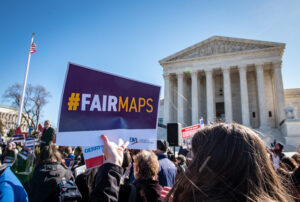
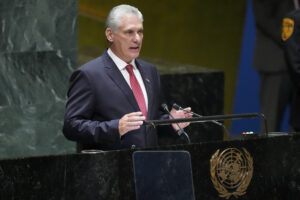
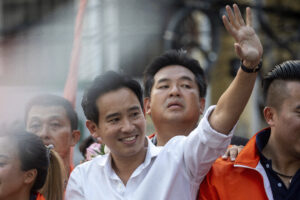
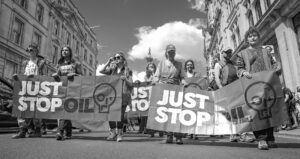
You need to be a supporter to comment.
There are currently no responses to this article.
Be the first to respond.